Roger J. Wendell
Defending 3.8 Billion Years of Organic EvolutionSM


Q: What's the difference between a commercial ski slope and a logging clearcut?
A: Clearcuts grow back!!
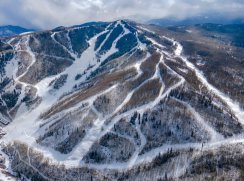
"Ski lifts need power to keep turning all season, resort buildings need energy, snow groomers need fuel and guests need to travel, often creating large carbon footprints from long flights."
"...resorts now need water-thirsty snow cannons to ensure enough of the white stuff for the business to operate. And that doesn't even factor in the physical and visual impact of development on the alpine environemnt."
- Rob Hodgetts
CNN Travel
December 10, 2022

|
Click Here for my skiing experience at Margy's Hut and the house of Hunter S. Thompson! |

|
Click Here for a few pix of Steve Farley and I skiing in our "backyard" on Green Mountain! |

|
Click Here for my video of a ski run down the Butler Gulch trail... |

|
Click Here for my page about Snow Caves and Quinzhees... |

|
Click Here for my Snow Day page... |
A Definition

Lito Tejada-Flores in his 1981 book,
Backcountry Skiing (The Sierra Club
Guide to skiing off the Beaten Track) pp. 1-2
"Backcountry skiing is not new. No more than skiing itself. In fact, what I think of as backcountry skiing - skiing away from ski area, off the beaten track, far from the crowd - has much more in common with early skiing than with today's prepackaged, high-priced versions of the sport. You don't need a lift ticket or a trail pass to go backcountry skiing. You don't have to join a ski club or wear the right clothes in the right colors. You don't even have to use a certain type of skis or a particular technique. Simply skiing into the winter landscape, away from prepared terrain, on your own or with friends - that's what I'm talking about and what this book is about.""Backountry skiing, like the backountry, has a lot to do with one's state of mind. The backcountry does not begin 3.7 kilometers or a two-day walk from the roadhead. Rather we feel ourselves in the backcountry when a mantle of overcivilized responses slips away, when a peculiarly urban weight lifts from the spirit, and the landscape seems to promise adventure, or at least the possibility of adventure.
"So with backountry skiing. It is not synonymous with arduous expeditions in remote regions, though they are definitely a part of backcountry skiing. It is not a sport reserved for super athletes, though they will find it endlessly challenging. Backcountry skiing is accessible to families, to children, to those who have spent their whole lives skiing and to those who never saw a ski before the age of forty. The essence of backcountry skiing is skiing on your own. You and winter. Your skis and untracked, unprepared snow. It is definitely a state of mind you put on, much as you put on your skis and boots. It's a state of mind composed of audacity and prudence, a love of winter and of effort, of graceful movement, and of exploration. In this overexplored world of ours, the winter backcountry is always fresh and unexplored because it's always changing; each storm, each shift in temperature creates new terrain. The backcountry - mountains, forests, high plateaus - has been renewing itself every winter beyond all memory. And as long as I can remember, skiers too have been renewing themselves in the challenging, white environment."

|
Click Here for the Ten Essentials - Don't leave home without 'em! |
The Case Against Ski Resorts:
ALAW and the liftline...Okay, I have an obvious bias here! I've been to ski resorts in California, Canada, Europe, Utah and all over Colorado and they're all pretty much the same - expensive fashion shows that have little respect for the natural environment (they're usually crowded, overbuilt clearcuts that take too much water for snowmaking and saunas) or solitude. However, downhill skiing does offer you a lot of social interaction if you love long liftlines, packed parking and crowded shops! Backcountry, cross-country, telemark, and touring are modes of skiing much different than the "downhill" drudgery I mention above! First, these types of skiing excursions don't cost much since you're not paying for an expensive lift ticket or latte. Second, since you need to get to the top under you're own power it's a much healthier workout than you'd ever get at Aspen, Mammoth, or Chamonix.
Finally, the backcountry (if you're lucky enough to be free of the snowmobiles!) is a clean, healthy, beautiful, and exhilarating experience that can't be matched in any manmade artificial environment! There's nothing like carving a few turns down the side of the Continental Divide with nothing but wilderness visible in every direction!
There's no doubt that backcountry skiing is about as low impact as it gets - just a couple of tracks through the snow and wildlife that's protected from another parking garage or ski lodge. Give the backcountry a try and you'll never go back to Vail!
- Roger J. Wendell

Cross-Country Skiing & Health:

Avalanche Awareness and Safety:
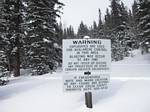 Butler Gulch trailhead warning |
On 03/22/05 my friend Janet Farrar took these photos of an avalanche northeast of Jones Pass here in Colorado (this avalanche was just west of Vasquez Peak on the south east slope of the unnamed 12,316' peak on the Continental Divide). As beautiful as these pictures appear avalanches kill many people each year. Ken Booker (and other acquaintances of mine) died in an avalanche so I hope you'll visit the Colorado Avalanche Information center page to raise your safety awareness level! |
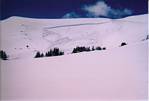 Jones Pass avalanche |
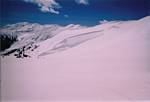 Jones Pass avalanche |
Please take an avalanche safety awareness course, at a minimum, if you're going to spend any amount of time where's there's a chance of an avalanche! Each year, 20 to 40 people die in avalanches in North America. 90 Percent of those deaths are from slides triggered by the victim or members of the victim's group. And, unfortunately, there's only a 30 percent chance of survival if you're buried by an avalanche. So, it's very important you know what you're doing in backcountry snow conditions! Here, in Colorado, we have a variety of resources since our mountains and snow conditions can be so dangerous. The best place to start is with the Colorado Avalanche Information Center. Also, the Colorado Mountain Club is a great resource for training and information as well.

Back to the Backcountry!
Montezuma, Colorado
Population 42, Elevation 10,200 feet (3,109 metres)
Montezuma is located near the resort of Keystone, Colorado and provides
some handy parking for backcountry skiers interested in sometime quiet
destinations like St Johns or the Hunki Dori and Wild Irishman mines.
Unfortunately noisy, smelly snowmobiles have access to much of the area,
as well, so be careful!
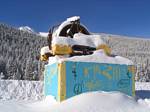 Towne Centre |
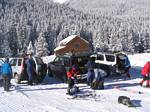 Public parking |
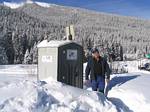 Public Restroom |
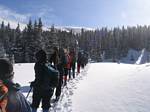 CMCers on the move! |
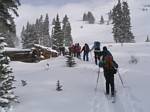 Wild Irishman Mine Cabin |
On January 6, 2007 CMC leader Dave Callais took 13 of us on the seven mile roundtrip tour of the Wild Irishman mine. Temperatures, that day, averaged about 10 degrees with strong wind gusts later in the afternoon (there was a huge avalanche near Berthoud Pass, not far from us, while we were skiing that day...).

Miscellaneous Ski Trips:
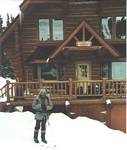 1. |
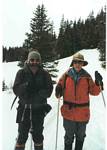 2. |
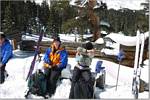 3. (Photo by Tom Bresnahan) |
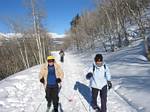 4. |
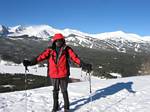 5. |
 6. |
|

McCullogh Gulch
(Quandry Peak, Colorado - leader Rocky Smith 03-11-2006)
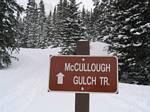 McCullough Gulch Sign |
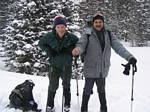 Rocky Smith & Me! |
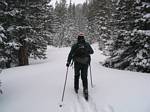 Rocky Smith Breaking Trail |
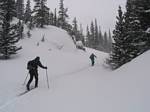 Going up hill... |
 McCullough Gulch Trail |
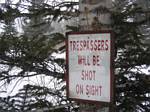 Trespassers will be shot! |
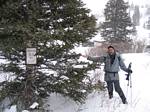 A Trespasser... |
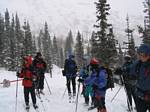 Our group |
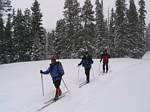 In Line... |
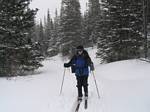 Andrea |

Spruce Creek
(Frasier Experimental Forest, Colorado - leader Mark Porter 02-25-2006)
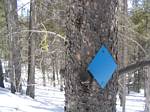 Typical Trail Marker |
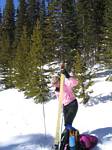 Removing Skins |
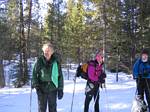 Mark, our leader! |
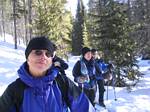 Nancy |
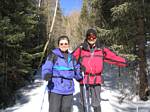 Nancy and Roger |
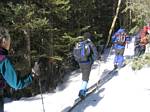 Going Up Hill |

"Waxless" skis:
Although waxless skis require almost no maintenance, they do, indeed benefit from glide wax at times. Also, waxless don't seem to do any better when going up hill - I can usually keep up with somebody on waxless, while using my waxable skis, if I've applied the correct temperature of wax. And, of course, "skins" (a friction fabric attached to the bottom of each ski when going up steep hills click Here for an explanation and comparison) beat waxable and waxless on terrain only snowshoers can access. 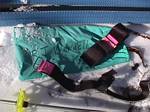
I'll admit that waxless skis sometimes provide more control, due to their enherent friction, when going down really steep terrain. Again, if conditions are that bad I usually slap the skins back on to my waxables to slow me down a bit. Of course telemark turns, if you've mastered 'em, are usually the solution in any steep terrain...
My Unofficial Waxing Notes:
Anyway, here are some rough notes that might help:
- At the start of the season, or if you've skied a lot this season, use Paint Thinner/Wax Remover to get rid of the old stuff.
- Drip on glide wax (Blue, usually in the range of about -6C to -12C) from tips to tales by holding to the bottom of an iron, i.e., you're actually holding the wax stick to the iron and letting the melted prodcut fall onto the bottom side of the ski.
- Then iron it so it covers the whole bottom in a smooth surface that permeates all the pores.
- Chip off excess including the straight track down the middle.
- Rub kicker wax, usually a temperature rating similar to the glider, in the wax pocket directly beneath the the bindings. Blue Extra (Oc to -6C) works good for most conditions in Colorado.

|
Click Here for my video that explains the wax pocket! |


|
Click Here for "Wood N Skis" (a site dedicated to wooden skis!)... |
Pine Tar:
In 2002 a friend in Virginia wrote to ask how she could care for her old wooden Nordic skis with pine tar. Having no clue, I posted a note on one of the CMC's listservers and received replies from Don MacLeod, and a host of others, with all kinds of great info. Don suggested an old book he owns for an authoritative analysis of the Pine Tar question:
A beginner's guide to Cross-Country Skiing:
A step by step introduction to cross-country skiing in North America, by Ned Baldwin.
Copyright 1972 Greywood Publishing Limited, 101 Duncan Mill Road, Don Mills, Ontario.
U.S.A. Distribution by Simon & Schuster Inc.
"Before waxing any wooden ski, the sole of the ski must be prepared by the application of a base
preparation. This is applied to the bare wood and is usually a pine tar derivative or similar
black sticky semi-liquid compound. New skis often come with a light brown coating on their bottoms
which is to protect the wood during shipment from moisture. This should be sanded off with light
sandpaper before application of the base."To apply the base, place the skis against a table or some similar object about 3 feet high and
brace tails of the skis against the wall or a cleat nailed to the floor so that they will not
slip. The materials you will need are an old towel, a propane blow torch, and a small can of base
material, commonly called Grundvalla. First, heat the ski slowly from one end to the other,
passing the torch back and forth several inches from the surface, warming it gradually. When the ski
is quite warm to the touch, start applying the grundvalla with a section of the old towel until the
entire ski is coated with quite a heavy layer."It is wise to protect the floor with newspapers during this whole operation. But do not worry about
the grundvalla which runs off the bottom of the ski on to the top of the ski as this is easily cleaned
off later with a rag moistened with turpentine. After the ski is fully coated with grundvalla, start
heating it again with the torch, a small section at a time, until it begins to boil. Just before or
immediately after it catches fire, wipe if off with the old towel."Continue this process, doing not more than a few inches of ski at a time until completed. This 'cooks'
the grundvalla into the surface of the wood and when you are finished, you have a very smooth and
relatively dry surface, ready for the application of waxes. You will find that you have to repeat this
operation several times during the course of the season, especially if you ski on icy conditions very
often. If you only ski on soft powder snow, your base may last for an entire season."After preparing the base, it is wise, although not absolutely necessary to apply a thin binder
wax, or Grundvox, before applying your finish wax. This product comes in a small tube and is
rubbed on very lightly and smoothed out with the palm of your hand or a cork. When it is on, it is
barely visible, only sufficient wax remaining on the ski to leave a fingerprint."

|
|
Bring These:
|

My Gear:
Most of the gear I love was 20 years old by the time I posted these pix on my skiing page! My Fischer 210 cm GTS backcountry skis were state-of-the art back then but couldn't keep up with the turns that the newer, more "shapely" skis are capable of now. Nevertheless, my Fischer skis, Asolo Snowfield II boots, and Riva cable bindings (I insalled 'em myself after having wore out the original three pin bindings...) have served me well in all kinds of terrain and conditions. At the end of '07 and the beginning of '08 I photographed my gear before it got too much more beat up!
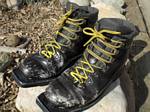 Asolo Sport Snowfield II |
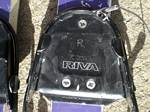 Riva Cable Binding |
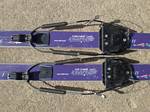 Riva Cable Bindings |
|
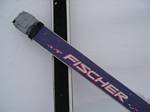 Duct taping my skins!! |
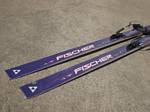 Fischer GTS 210 cm skis |
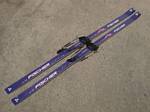 Fischer GTS 210 cm skis |
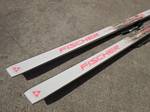 Bottom side with dirty wax! |
Okay, you'll notice the letter "R," and even my initials, engraved in the cable binding (and on everything else!). The "R" (and "L" on the other binding) are to identify which foot that particular ski goes on. I know, you'd think I'd have my left and right figured out by now but, believe me, at high altitude or after a day of exhaustion little things like this help you keep your gear on the correct feet! For example, on my plastic mountaineering boots I even have the letter "L" printed backwards - I got that great idea from being really hypoxic one day at 21,000 feet - very much disoriented and in need of every bit of help in putting my gear on correctly! And, of course, my name and initials are on everything not so much as to prevent theft (which they won't) but to ensure my gear doesn't get mixed with somebody else's similar looking equipment...

Brainard Lake, Colorado:
Colorado Mountain club
Brainard Lake cabinThe Boulder Group, of the Colorado Mountain Club, maintains this great little cabin adjacent Brainard Lake. You'll need to contact the club to make reservations if you're interested in staying there, etc. Click Here for my YouTube video from inside the cabin!
Practice Makes Perfect!
Pulling sleds for DenaliThroughout Colorado's backcountry it's common to find folks preparing for big climbs in other places around the world - our 14,000 foot peaks are the perfrect workout for anyone aspiring to even higher adventures around the planet. In this case, these guys were peparing for Denali, in late spring, and agreed to let me photograph and film them. They're all pulling sleds, along with their packs, to accommodate all the gear they'll need for many weeks on the mountain. Click Here for my YouTube video of these guys pulling their sleds uphill...

Earn Your Turns!
The term, "Earning Your Turns," originated from backcountry skiers in search of pristine, untouched snow. It usually involves bypassing ski lifts and other mechanized means of getting to the top of a ski run or mountain. The idea being to ascend by human power alone - very much like the 3,000 foot "rule" for climbing 14ers (where any mechanical advantage isn't allowed).
"Earning your turns" usually requires equipment that allow you to make your way uphill without the use of a ski lift or gondola. In my case, I've been able to achieve this on easier slopes with a simple application of wax (usually Blue Extra) here in Colorado. Steeper, longer runs uphill might require special bindings and ski bottoms lined with "skins" - material or fabric designed to provide traction in the snow. The name "skins" originated in the past when seal skins were used - nowadays the materials are synthetic. Some ski bottoms are manufactured with "fish scales" that point backwards so as to keep the skier from sliding downhill. These "fish scales," in return, povide ease-of-movement going uphill and allow skiing back down.
Many ski resorts now allow backcountry skiers access to their slopes before and after regular operating hours. So, the skier gets a good workout going uphill, and then a long, wonderful ride down a groomed slope without having used a lift or gondola. Plus, there's the added benefit of very few other skiers on the slopes! However, always check with the ski resort you're interested in to ensure you're complying with their regulations - especially anything related to safety!
In my case, and that for many others, I don't often "earn my turns" at a skir resort or groomed run. My preference is to be in the backcountry on natural terrain to enjoy nature, and the physical workout, to the fullest! Caution though! Avalanches are a huge safety concern so be trained, be aware, and be safe!

Backcountry Books:


|
Click Here for red, pink, and "Watermelon Snow" at the bottom of my Snow Day page... |
Links:
|
|
| Warning! Climbing, mountaineering, and backcountry skiing are dangerous and can seriously injure or kill you. By further exploring this website you acknowledge that the information presented here may be out of date or incorrect, and you agree not to hold the author responsible for any damages, injuries, or death arising from any use of this resource. Please thoroughly investigate any mountain before attempting to climb it, and do not substitute this website for experience, training, and recognizing your limitations! |

 Back to Roger J. Wendell's Home Page...
Back to Roger J. Wendell's Home Page...
Abbey |
About |
Blog |
Contacting
Me |
Copyright |
Disclaimer |
Donate |
Guest
Book |
Home |
Links |
Site
Index |
Solutions |
Terms,
Conditions
and
Fair
Use |
What's
Changed
or
New?
Copyright
© 1955 -